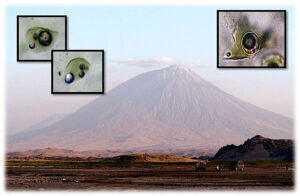France, L. ; Brouillet, F. ; Lang, S.
Comptes Rendus Géoscience – Sciences de la PLanète (2021), 353, S2, 273-288
`Voir en ligne : https://doi.org/10.5802/crgeos.99

Abstract :
Carbonatites are unusual C-rich alkaline magmas that have been reported throughout the geological record. Nevertheless, there is only one currently active carbonatite system on Earth : Oldoinyo Lengai stratovolcano in northern Tanzania (God’s mountain in Maasai culture). Presentday Lengai carbonatites are natrocarbonatites, peculiar Na-rich carbonatites that, under atmospheric conditions, alter and leach to compositions similar to the more common Ca-carbonatites within weeks, preventing any long-term geological record of such Na-rich magmas. It follows that the oldest report of natrocarbonatites at Oldoinyo Lengai dates to the 19th century. Here, by using samples from the Lengai I cone (È11 ka), we show that immiscible silicate–carbonatite melts were already present at reservoir conditions at that time. Measurements of three-phase (carbonatite + silicate + gas) melt inclusions from Lengai I highlight that their chemical compositions were similar to those of immiscible melts recently present in the reservoir. Alkaline carbonatites in melt inclusions from both Lengai I and historical explosive eruptions are enriched in Ca relative to those historically effused at the surface and likely record higher equilibrium temperatures (>1100 °C). We also report chemical maps that qualitatively document elemental partitioning between immiscible silicate–carbonatite melts.We show that at the melt inclusions’ entrapment conditions Si, Fe, K, Na, and Cl are compatible with the silicate phase when C, Ca, P, Sr, Ba, and F are compatible with the carbonate phase.



